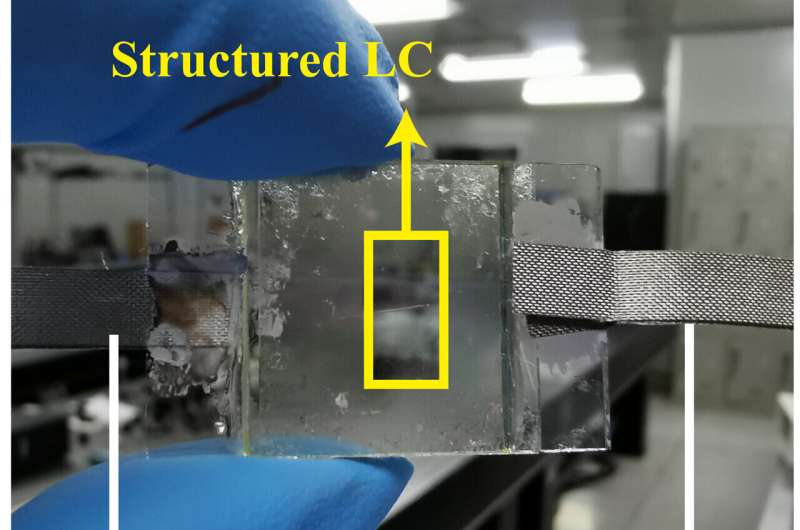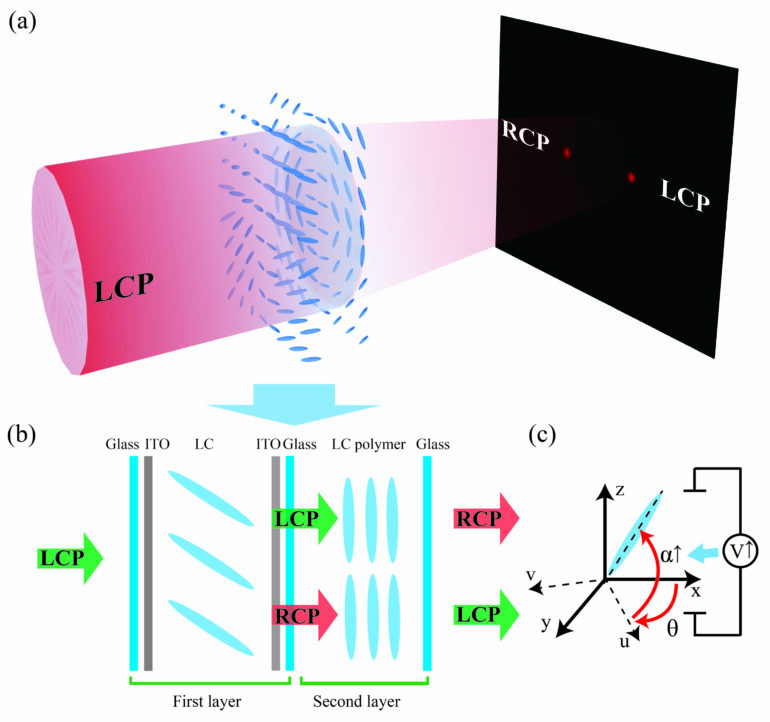Researchers have developed a new type of bifocal lens that offers a simple way to achieve two foci (or spots) with intensities that can be adjusted by applying external voltage. The lenses, which use two layers of liquid crystal structures, could be useful for various applications such as optical interconnections, biological imaging, augmented/virtual reality devices and optical computing.
“Most liquid-crystal-based devices are made from single-layer structures, but this limits light field modulation to a confined area,” said research team leader Fan Fan from Hunan University in China.
“We used bilayer structures composed of a liquid crystal cell and a liquid crystal polymer to realize more complex and functional modulation of incident light.”
In the journal Optics Letters, the researchers show that the new bifocal lenses can be used for polarization imaging, which is often used to enhance image contrast, and for edge imaging, which highlights the outlines of objects, making it easier to see fine details or spot certain shapes. The paper is titled “Bifocal lenses with adjustable intensities enabled by bilayer liquid crystal structures.”
“In virtual or augmented reality devices, bifocal lenses are commonly used to adjust the distance of the image display to overcome vergence-accommodation conflict, which can cause visual discomfort and eye strain,” said Fan.
“We believe that the light control mechanism we created using the multilayer structure could also be used to design other optical devices, including holographic devices and beam generators, or for optical image processing.”

Researchers developed a bifocal lens based on two layers of liquid crystal (LC) structures. The intensities for the two focal lengths can be easily adjusted by applying external voltage. © Fan Fan, Hunan University
Inspiration for a new design
The design for the bilayer bifocal lens was inspired by the rapid development of multi-functional holographic devices. “Researchers have devised many methods to improve the information capacity of holographic devices, including holographic devices based on multi-layer structures,” said Fan.
“We thought this type of structure could be useful beyond the field of holographic displays, so we tried to expand its application scenarios.”
Although some bifocal lenses can create different focal points depending on the incident light’s polarization, the new bilayer bifocal lenses actively manipulate the polarization states of the output beams. This allows the bilayer lenses to split left-handed circularly polarized light into two focused light beams, one with left-handed and one with right-handed circular polarization.
The liquid crystal cell layer also enables the bifocal lenses to rapidly change foci intensity in response to an external voltage. Previously developed bifocal lenses required mechanical rotation of the wave plate to accomplish this.
After confirming that the bifocal lens’s point spread function—a measure of the ability to focus light—agreed with theoretical calculations, the researchers incorporated the lens into imaging systems for polarization and edge imaging. For polarization imaging, the separation distance between the two foci is large (2 millimeters) while edge imaging uses a small (0.03 millimeters) separation distance with equal intensity for the two focal points. They showed that the bifocal lens performed well for both types of imaging.
Expanding to more applications
The researchers are now working on designing and manufacturing more multifunctional devices based on the bilayer structures for use in other research applications. They note that making these optical components practical will require lowering the cost in their mass production, incorporating the ability to adapt to different environments and designing fast and accurate layer-to-layer alignment technology.
“With this research, we aimed to illustrate the huge potential of bilayer structures for optical devices and the advantages of liquid crystal devices in electrical tunability,” said Fan. “We hope these unique features inspire scientists to develop even more advanced applications.”
More information:
Yingjie Zhou et al, Bifocal lenses with adjustable intensities enabled by bilayer liquid crystal structures, Optics Letters (2024). DOI: 10.1364/OL.537415
Citation:
Researchers harness liquid crystal structures to design simple, yet versatile bifocal lenses (2024, October 1)



